BenWil Marketing Agency Launches Cutting-Edge SEO Services in Bangladesh EIN News
source
Uncategorized
TikTok: What Marketers Need to Know – Social Media Examiner
Social Media Examiner
Your Guide to the Marketing Jungleby /
Are you curious about TikTok? Wondering how to use TikTok for your marketing?
To explore what marketers need to know about TikTok, I interview Rachel Pedersen on the Social Media Marketing Podcast.
Rachel is an organic social marketing pro and host of the Social Media Secrets podcast. Her new book is called, I Need Attention.
Rachel shares how TikTok works, how marketers can develop content for TikTok, and more.
This article is sourced from the Social Media Marketing Podcast, a top marketing podcast. Listen or subscribe below.
Where to subscribe: Apple Podcasts | Spotify | YouTube Music | YouTube | Amazon Music | RSS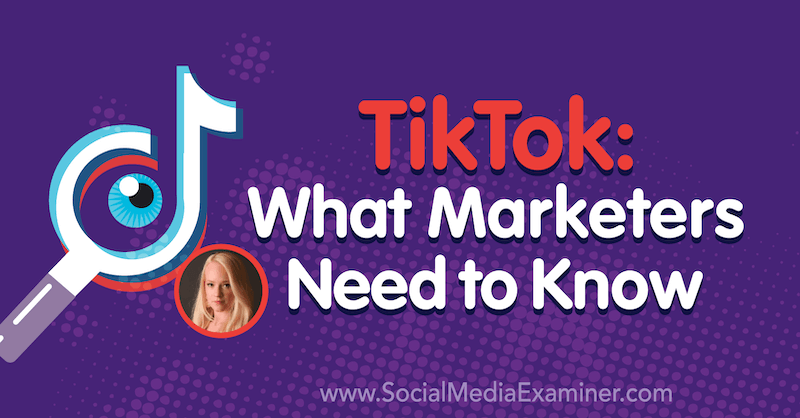
Rachel’s experience with social media marketing began when she was a hairstylist. As she was doing highlights on a client 3 years ago, the client asked for Rachel’s help in understanding Twitter on behalf of her husband’s chicken company. At that moment, Rachel realized that she may not be a social media expert, but she was certainly an expert in the client’s eyes.
She knew enough to help the client and her husband figure out Twitter, Facebook, and the world of marketing that had always intrigued her.
Rachel began talking to her client further about the chicken company’s social media game plan. Within a few months, she was invited to continue consulting for the entire franchise, and the company became her first official social media marketing client. According to Rachel, everything just continued to grow from there.
Rachel now focuses on creating organic social media strategies that drive consistent revenue for renowned clients that do 7, 9, and even 10 figures a year in revenue. She’s helped Fortune 500 companies and famous people go viral on social media. So when she started hearing the buzz about TikTok, she immediately recognized it’s a new avenue that marketers haven’t yet explored.
Rachel began using TikTok in winter 2018. As soon as she joined this new platform, she wanted to understand it as quickly as humanly possible. Although she feels like she came late to the platform, she’s still ahead of the marketing industry and an early adopter among her peers.
TikTok was previously a popular app called Musical.ly, where users mainly posted lip-syncing videos. The first time Rachel scrolled through TikTok, she saw video after video of this type of content. She and her children joined the fun by sharing their own rendition of the song “Baby Shark” on TikTok.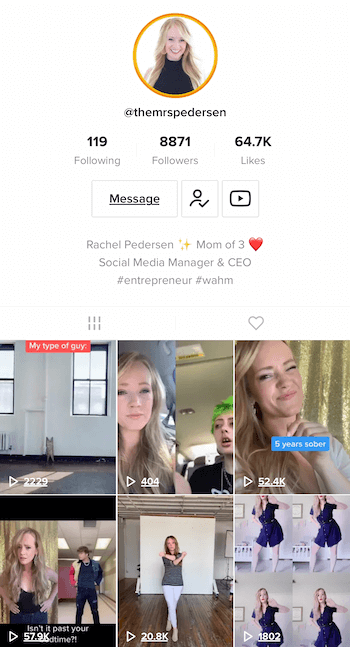
Get expert training and an unbeatable conference experience when you attend Social Media Marketing World—from your friends at Social Media Examiner.
Broaden your reach, skyrocket your engagement, and grow your sales. Become the marketing hero your company or clients need!
🔥 As a valued reader, you can save $820 on an All-Access ticket if you act now. Sale Ends Tuesday! 🔥
Rachel confesses that it felt awkward putting up her first video on TikTok, but she posted it anyway. In spite of having only six followers, her first video was viewed by 9,400 people by the next day. She immediately saw a big opportunity in TikTok that neither Facebook nor Instagram can deliver.
Hungry to dive into and experiment with TikTok, Rachel created videos almost every day. With very little effort and zero spend, her TikTok following grew to nearly 2,600 within 60 days.
She attributes TikTok’s growth to a number of factors. The app has an unweighted algorithm that organically surfaces videos in the order that they’re shared. It offers hashtags that operate without bans or slowing down the videos.
We’re moving into an era of shorter attention spans. Most people are only interested in things for 15 seconds, like videos you see on TikTok, movie trailers, or ads. Within those 15 seconds, the viewer gets to decide whether they want to binge more content. The trick is finding a way to capture and sustain their attention in that 15 seconds, especially if they’ve never heard of you.
TikTok isn’t a new platform; it’s a platform with new energy. It offers so much opportunity for marketers who are looking to be the first of their generation to be on it. Most marketers haven’t moved to TikTok in massive packs yet so it’s still a little isolated and more like the Wild West. It’s gaining traction and being introduced to the masses, though.
Data and demographics for TikTok in 2019 state it’s currently in 154 countries and has about 500 million active users. TikTok has consistently been in the top 10 most downloaded apps in the App Store.
Among TikTok’s users, about 66% are younger than 30 and there seem to be plenty of teen and college-age users on the site. Yet, in Rachel’s experience, hashtags like #MomLife, #MomOfThree, and #WorkingMom are active and constantly pull video content from Millennials between ages 20 and 30. There are a lot of younger moms and others who seem young, which means TikTok is an ideal platform for any brand wanting to get in front of this valuable audience.
I add that fitness influencer Chalene Johnson is active on TikTok and she attracts the 50+ crowd. Zach King, who’s known for having 20 million Instagram followers and is super-famous on YouTube as well, is also active on TikTok and he’s a fairly young guy. At a high level, there’s a wide range of ages and people on TikTok.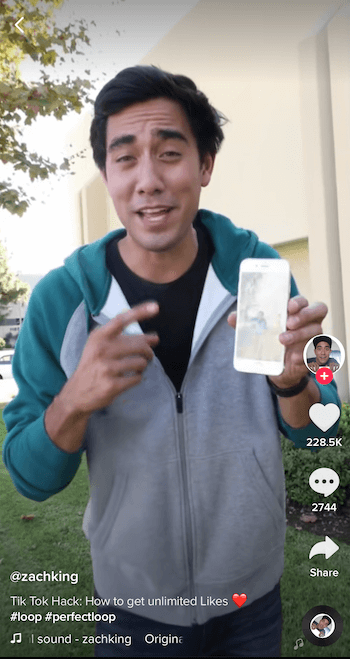
Rachel also notes users are spending $50 million on virtual gifting on TikTok and the platform is in the early stages of testing a self-serve ads program. She goes into detail about both of these programs later in the interview.
TikTok features two side-by-side feeds. The main or default feed on the right features a seemingly endless stream of content that’s been tailored “For You.” As you swipe through these videos, you can follow the accounts, engage with the content, and more. The feed on the left features content from accounts you already follow. You can easily toggle back and forth between the two feeds.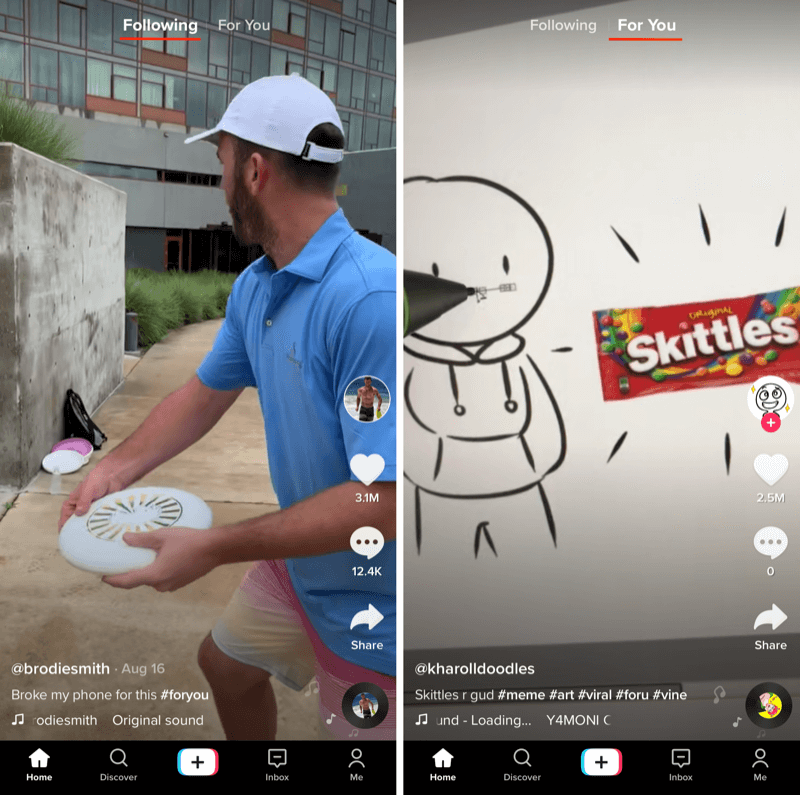
When you open the app for the first time, you’re presented with a clear news feed. It doesn’t know your preferences so what shows up in the For You feed will be totally random until you start engaging with content. It typically features users you don’t follow and content you haven’t seen. Once you start following and interacting with other users, the app will begin surfacing similar content and creators in the For You feed.
TikTok offers a wide variety of content. Much of it is quite entertaining but Rachel warns that some of it is inappropriate and shocking.
All videos in TikTok are vertical and take up your entire phone screen. A majority of the content is typically 15 seconds or shorter, but the video clips have since been expanded to up to 60 seconds. All TikTok videos are looping.
I note that TikTok is very similar to Vine, a Twitter-owned video platform that was once very popular and suddenly shut down.
Like other social media platforms, TikTok has its own version of verified status once an individual reaches a certain level of notoriety and popularity on the platform. TikTok bestows this recognition and it essentially elevates the person’s status among other users.
Rachel notes that TikTok seems to do a really good job of identifying quality creators who are consistently producing great content. Verification is another way in which TikTok supports the creators who are helping to grow and improve the platform.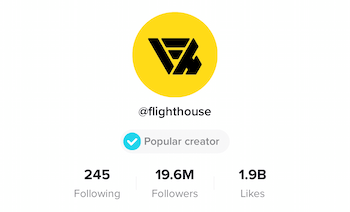
Live video streaming is available on TikTok, but only once you’ve reached 1,000 followers. While that seems like a low follower count compared to other social media platforms, it’s very difficult to achieve on TikTok without an intentional strategy for gaining and keeping an audience’s attention. It’s easy to get people to watch your videos, but not to get them to subscribe and follow you.
When you go live on TikTok, your video will be shown to all of your followers in their feeds. The alert that you’ve gone live is clearly displayed at the top of their feed and on their notification bar. People can then share your live stream with all of their followers, resulting in the potential for exponential growth on TikTok. Once your live video is done, it disappears completely and is gone forever.
Once the ability to record live video is unlocked on your TikTok account, you’ll find it’s similar to YouTube’s live-streaming product. People can purchase virtual gifts within TikTok using one of several in-app currencies. The most common one is coins, which are obtained in different bundles with actual money.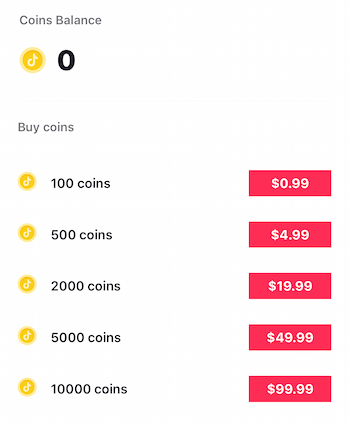
The virtual gifts, which are essentially emoji stickers with funny names like Concert, Cowboy, and Drama Queen, can be used to reward creators for having great content. The gifts come in a range of values and sizes between $0.50 and $50 and can be converted back into real money, of which the creators keep some portion of.
If your live stream attracts hundreds or thousands of people, you have the potential to earn hundreds or even thousands of dollars if each of them contributes as you broadcast.
TikTok has a phenomenal hashtag system, but hashtags are limited by the short 140 characters allowed for each video caption. This caption must include not only the entire video description but also needs to have all of the hashtags that you want to rank for.
Rachel adopted a practice of adding a combination of niched-down hashtags, as well as very general ones to her TikTok videos. The hope is that your video will be found in the smaller hashtags and then will continue to rank as you move up into the bigger hashtags. The more users engage with your video, the further up it will rank within the different hashtags.
Captions on TikTok appear on top of the videos as they play and remain for the duration of the video like they do on Instagram Stories. According to Rachel, captions can be placed anywhere on the screen and are graphic-based text rather than true text.
Our newest show, AI Explored, might be just what you’re looking for. It’s for marketers, creators, and entrepreneurs who want to understand how to use AI in their business.
It’s hosted by Michael Stelzner and explores this exciting new frontier in easy-to-understand terms.
Pull up your favorite podcast app and search for AI Explored. Or click the button below for more information.
Although the platform currently doesn’t support clickable links within the videos or a swipe-up option, users can include a link in their TikTok bios. Rachel noticed a recognizable jump in her website traffic when another user visited her profile and read the URL in her bio during a live broadcast on TikTok. It wasn’t a significant jump, but it was enough to make other people go and search for her website.
Like video captions, the bios on TikTok are also limited to 140 characters of plain text and emojis. The 140 characters can include a link to your website; however, the URL isn’t clickable. You can upload one profile photo and your previous ones aren’t saved in an album as they are on Facebook.
Rachel admits that analytics in TikTok are lacking. Creators can currently only see how many people have watched their videos and how many have reacted to them. You can also see who has viewed your profile. That’s about it.
TikTok doesn’t provide demographic data on your followers or users who’ve engaged with your content on the platform.
When it comes to TikTok, videos that are overproduced, too corporate, or overtly promotional tend to spark outrage. Rachel has witnessed people go crazy in the comments when they sense a regular user is trying to sell them something or sneak in an ad.
Rachel suggests taking the time to research what the content on TikTok feels like and create videos that naturally blend within this environment. Watch other people’s content and start to identify and adopt the trends you see.
As more people are becoming “TikTok-famous,” the platform is beginning to explore how to natively integrate advertising. TikTok recently began experimenting with a new self-serve ad platform as major brands clamor to reach the younger demographic on the platform.
I mention that Macy’s recently used TikTok to run a back-to-school campaign targeting high school and college kids. Rachel recalls alcohol brands, concerts, big parties, and musicians being promoted on TikTok too.
Once TikTok’s ad program is fully rolled out, marketers will be able to diversify their clients and offer something beyond Facebook, Instagram, Twitter, and all of the other trusted platforms we’ve relied upon until this point. You’ll begin seeing more ads throughout the feed and notifications in the future.
When you open the TikTok app to create content, there are several different options for getting started. Similar to Instagram Stories, you can hold down the button for the entire duration of the video to natively record. You can set up a self-timer and record from a distance. You can also create a series of short segments that come together to form a longer video.
TikTok encourages users to create native content within the app but allows pre-edited videos to be uploaded too. Users can then add awesome effects and text throughout different parts of their videos to make them interesting and fun. TikTok videos can also be downloaded and repurposed for other platforms like Facebook or Instagram.
Videos on TikTok are a combination of lip-syncing to original and uploaded music, sound effects and audio clips, rants, and anything else the imagination can create.
TikTok’s roots are in music content but Rachel observed that users are moving away from singing along to music and going more towards creating their own snarky renditions of songs. The user will sing new lyrics to a song and create a video with a funny take, creative interpretation, or double meaning of the words.
Start by observing funny things that happen throughout your life and look for inspiration everywhere. Rachel’s standbys for inspiration are Reddit and Twitter. If she goes there and discovers that other people like her or people in her target audience are intensifying or reacting to a certain thing, she’ll make a funny video about it.
For example, Rachel identifies as a working mom. She sees that other women online in her age group are sharing their frustrations with being a working mom too. So she thinks that it might be funny to create a video where she wears a blazer on top and pajamas on the bottom and calls it the “conference call look” as a way to reach this audience.
If Rachel is in an airport, she looks for airport hashtags on TikTok and other platforms. She takes note of the different things others have done and that she can adopt for her TikTok videos. She looks for things she can do in her particular location or while she waits.
Rachel notices that many videos have a plot twist midway, at approximately 7 to 10 seconds. Things will appear to be going a certain way in the beginning and then take a totally different direction that shocks everyone.
The initial shock makes people want to see it again with a fresh perspective. They get hooked into watching it over and over. Then they come back to leave comments or tag their friends to share it with them. This is the goal.
In one of Rachel’s videos, she puts uncooked macaroni noodles between her teeth and asks her eight-year-old daughter to walk on her back. As her daughter walks on her back, Rachel crunched the noodles in her mouth. Not realizing it was just a prank nor that Rachel was recording a video, her daughter started crying instantly.
Rachel thought it was so funny that she couldn’t stop laughing. With 10,000 views in just 48 hours, her audience apparently loved it too.
When you create and upload a video using your own voice or sound effects on TikTok, you get attribution for that sound forever. This means that any video that reuses your audio clips will ultimately be directed back to your account. Uploading your own sounds is another way to grow and lend some positivity toward your brand on TikTok.
To illustrate, Arnold Schwarzenegger uploaded some incredibly interesting native audio clips to TikTok and instantly went viral with everyone looking to reshare just one of his videos. TikTok users are so excited about creating their own videos around Arnold Schwarzenegger’s audio clips that Rachel can’t look through her TikTok feed without seeing someone using his native sounds.
In fact, people were so enthusiastic about it that when the next video in his feed is an ad for his protein shake, which he also uses the platform to promote, people had an overwhelmingly positive reaction to it.
Rachel shares that she plans to use TikTok for exposure and growth over the next year. She’ll do this by nurturing a younger following on the platform and preparing this audience to know who she is in the next 10 or 20 years.
Most people haven’t realized that TikTok video offers the ability to pitch or create trainings. Most creators hop on and just create videos about their regular life—putting on makeup, practicing an instrument, or playing a video game as people do on Twitch.
Rachel plans to launch live videos that train people how to become social media managers and strategists. Her strategy is to use these live trainings to drive traffic to her lead magnets and grow her email list.
TLDR This is a browser extension that automatically summarizes any articles, web pages, or other big blocks of text into five succinct bullet points. TLDR typically stands for “too long, didn’t read” on the Internet and the tool solves this problem.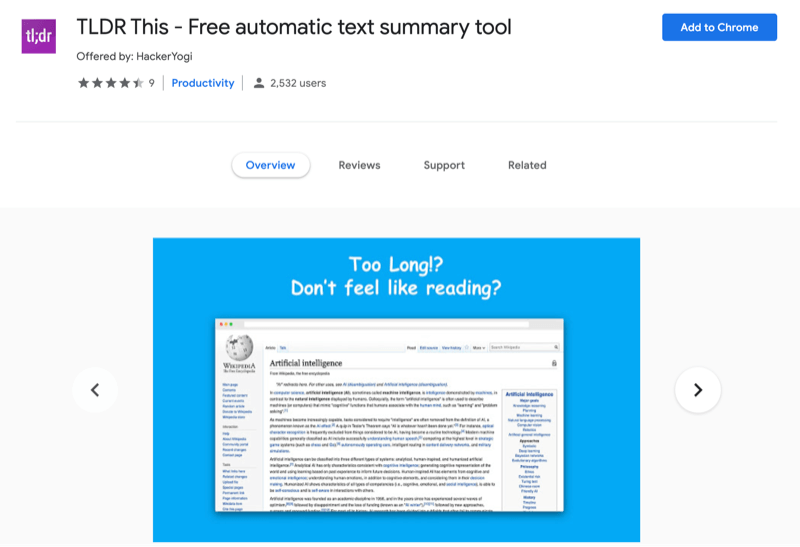
You drop a URL for a web-based article, or copy and paste the text into TLDR This. It skims the article and highlights the important points in a format that can be read in mere seconds. The summaries are written in full sentences that are grammatically correct, accurate, and straightforward.
TLDR This is available online as a web page and as a Chrome or Firefox browser extension.
Listen to the show to hear more about TLDR.
Help Us Spread the Word! Please let your Twitter followers know about this podcast. Simply click here now to post a tweet.
If you enjoyed this episode of the Social Media Marketing podcast, please head over to iTunes, leave a rating, write a review, and subscribe. And if you listen on Stitcher, please click here to rate and review this show.
What do you think? What are your thoughts on creating content for your brand on TikTok? Please share your comments below.
Want to go even deeper with your marketing? Check out the Social Media Marketing Podcast! Publishing weekly since 2012, the Social Media Marketing Podcast helps you navigate the constantly changing marketing jungle, with expert interviews from marketing pros.
But don’t let the name fool you. This show is about a lot more than just social media marketing. With over 600 episodes and millions of downloads each year, this show has been a trusted source for marketers for well over a decade.
Get our latest articles delivered to your email inbox and get the FREE Social Media Marketing Industry Report (43 pages, 60+ charts)!
Need a new plan? Discover how marketers plan to change their social activities in the 16th annual Social Media Marketing Industry Report. It reveals what marketers have planned for their social activities, content marketing, and more! Get this free report now and never miss another great article from us. Join more than 385,000 marketers!
Simply click the button below to get the free report:
Google’s Mueller Answers How to SEO a Podcast Site – Search Engine Journal
Join us in analyzing 3 case studies that show the importance of driving brand search behavior and engagement, and how to do it in months, instead of years.
Maximize your SEO efforts in 2024 with insights on Google’s SGE, algorithm updates, and expert tips to keep your site ahead.
Download this guide and learn how to optimize and manage Google Performance Max campaigns, with expert insights and actionable strategies to ensure your campaigns are effective.
Join us in analyzing 3 case studies that show the importance of driving brand search behavior and engagement, and how to do it in months, instead of years.
Join us in analyzing 3 case studies that show the importance of driving brand search behavior and engagement, and how to do it in months, instead of years.
Join us as we dive into exclusive survey data from industry-leading SEOs, digital marketers, content marketers, and more to highlight the top priorities and challenges that will shape the future of search in 2025.
In a Reddit discussion someone asked how to optimize an audio based site that featured podcasts and audiobooks. John Mueller and others in the Reddit community provided useful advice.
This is the original question:
“Our website is a PWA and it hosts audiobooks, podcasts, and audio shows how to tell google that treats us from that point of view because it may penalize us fr not having content on-page.”
PWA means Progressive Web App. It’s a website that behaves like an app.
The person asking the question noted that they had meta description, title and thirty to fifty words of descriptive content.
John Mueller reaffirmed that all pages need content in order for Google to understand what the page is about and subsequently rank it. John offers good advice and it’s printed below. However, the other users on Reddit provided excellent follow up.
First, here’s Mueller’s response:
“You always need textual content on-page, regardless of what other kinds of content you might have.
If you’re a video-hosting site, you still need things like titles, headings, text, links, etc. The same goes for audio-hosting sites. Make it easy for search engines to understand your content & how it’s relevant to users, and they’ll be able to send you relevant traffic.”
The part about “how it’s relevant to users” is interesting. Ordinarily many people tend to think in terms of describing what something is about. But a good way to solve the content writing problem is to first think about how the content is used by the site visitor and what they are trying to accomplish.
Mueller added:
“If you make it hard for search engines to figure out what your pages are about, it would be normal for them to struggle to figure out how your site is relevant for users.”
Mueller repeated his encouragement to describe how the content is relevant to users. It’s a good approach in terms of mapping out a content strategy.
Affiliate SEO Content Ranking Formula
It’s a content strategy that I’ve used for well over fifteen years for affiliate sites and I suspect many others use variations of it as well.
This is the essence of the content strategy: The content describes the product and what it can help the user accomplish. That’s it, that’s the formula.
The Reddit members offered several alternative SEO tips for podcasting sites, such as transcribing the content and structured data.
One member suggested transcribing the content so that Google could index what was said in textual form. That may be useful for certain kinds of content, particularly instructional content.
But I think one must consider that what was spoken might not always rank for what you want it to rank.
For example, some podcasts are people relating their personal history while some podcasts are about crime mysteries. Will transcribing the true crime podcast help that podcast rank for the phrase, True Crime Podcast?
It’s possible the page might end up ranking for random phrases. After all, the podcast itself is a story and not a description of what it is.
Another useful suggestion was structured data. That’s a good way to communicate data. This is great advice.
As with any implementation of structured data, be sure that whatever information you put into your structured data that the same information is available on the web page itself.
The information for podcast structured data can be found at Schema.org. It’s worth reading all the details you can provide. For example, you can add Review structured data if the podcast is a review of a brand, product, or place.
Additionally, Google requires an RSS feed in order to use it for Google Podcasts, Google Play Music, Google Search and more. Full information here.
There is also more information about Google Actions for Google Assistant here and at Google’s podcast developer page.
Google treats audiobooks a little differently in that there are Book Actions. For Book Actions they appear to give preference to retailers who publish a large selection.
From Google’s page on structured data for books:
“To ensure robust coverage and better serve our users, this feature is currently limited to book providers that have broad book availability.”
There is a link on that page where you can register to be eligible to show book actions.
However, the page has a section for rich results. It’s unclear if one has to register to have those rich results show up though. Rich results is different from Google Actions, right?
“You must include the required properties for your content to be eligible for display as a rich result. You can also include the recommended properties to add more information about your content, which could provide a better user experience.”
There are a number of required properties and recommended properties. The recommended properties are fine to not include if they’re not appropriate for your situation. View the full list on Google’s book structured data page. Find examples of audiobook structured data on the official Schema.org page for structured data here.
The answer to how to SEO an audiobook or a podcast contains many answers depending on your scenario. Mueller’s advice to create content that describes how and why the podcast or audiobook is relevant to the user is a great start. After that there are more solutions depending on audio that is being promoted.
Read the Reddit discussion here.
Related: How to Make Your Podcast SEO-Friendly
I have 25 years hands-on experience in SEO, evolving along with the search engines by keeping up with the latest …
Conquer your day with daily search marketing news.
Join Our Newsletter.
Get your daily dose of search know-how.
In a world ruled by algorithms, SEJ brings timely, relevant information for SEOs, marketers, and entrepreneurs to optimize and grow their businesses — and careers.
Copyright © 2024 Search Engine Journal. All rights reserved. Published by Alpha Brand Media.
Bengal cat lovers in Australia get psspsspss’d in Google-driven Gootloader campaign – Sophos
Once used exclusively by the cybercriminals behind REVil ransomware and the Gootkit banking trojan, GootLoader and its primary payload have evolved into an initial access as a service platform—with Gootkit providing information stealing capabilities as well as the capability to deploy post-exploitation tools and ransomware.
GootLoader is known for using search engine optimization (SEO) poisoning for its initial access. Victims are often enticed into clicking on malicious adware or links disguised as legitimate marketing, or in this case a legitimate Google search directing the user to a compromised website hosting a malicious payload masquerading as the desired file. If the malware remains undetected on the victim’s machine, it makes way for a second-stage payload known as GootKit, which is a highly evasive info stealer and remote access Trojan (RAT) used to establish a persistent foothold in the victim’s network environment. GootKit can be used to deploy ransomware or other tools, including Cobalt Strike, for follow-on exploitation.
Detection of a new GootLoader variant actively being used by adversaries earlier this year led to a broad threat hunting campaign by Sophos X-Ops MDR for GootLoader instances across customer environments. As is typical of Gootloader, the new variant was found to be using SEO poisoning—the use of search engine optimization tactics to put malicious websites controlled by GootLoader’s operators high in the results for specific search terms—to deliver the new, JavaScript-based Gootloader package. In this case, we found the GootLoader actors using search results for information about a particular cat and a particular geography being used to deliver the payload: “Are Bengal Cats legal in Australia?”
During the threat hunt campaign, MDR discovered a .zip archive used to deliver GootLoader’s first-stage payload while reviewing an impacted user’s browser history. This allowed MDR to identify the compromised website that was hosting the malicious payload. This report highlights the MDR investigation process and the technical details of the uncovered GootLoader campaign.
On March 27, 2024, the MDR team performed a proactive threat hunting campaign across multiple customers estates, following recently reported identification of a new GootLoader variant being actively exploited in the wild.
Our investigation revealed the threat actor was using SEO poisoning through an easily accessed online forum found via a simple Google search, initiated by the user for ‘Do you need a license to own a Bengal cat in Australia’. The first search result took us to this URL:
Immediately after the user clicks the link, a suspicious .zip file was downloaded to C:Users<Username>DownloadsAre_bengal_cats_legal_in_australia_33924.zip onto the victim’s machine, and the user’s browser was directed to the URL hxxps:[//]www[.]chanderbhushan[.]com/doc[.]php.
Upon review of the running processes, we were able to determine that a small JavaScript file was dropping a large JavaScript file at the location C:Users<Username>AppDataRoamingMicrosoft on the user’s machine. During our testing, the large JavaScript file generated by the malicious site and its name, downloaded to the user’s %temp% directory, were different each time the initial JavaScript was executed. The file we observed in this case was named Temp1_Are_bengal_cats_legal_in_australia_33924.zipare_bengal_cats_legal_in_australia_80872.js.
We additionally observed the creation of a scheduled task named “Business Aviation” with the command line “wscript REHABI~1.JS” (as shown in Figure 3). This was suspected to be a persistence method in which the threat actor was utilizing WScript.exe to execute the second-stage payload of GootKit.
We also noted the utilization of the command C:WindowsSystem32cscript.exe REHABI~1.JS spawning PowerShell.exe, as shown in Figure 4. The cscript.exe command line tool is specific to Windows Server. The commands passed to PowerShell were not captured in this case.
However, examining the URL history, we observed PowerShell.exe reaching out to the following domains, as shown in Figure 5. Third-stage payload
In the case the MDR team examined, our team did not observe the third stage being successful in reaching a full deployment of GootKit, preventing the download of any additional malicious tooling. This stage typically is where the deployment of additional tools such as Cobalt Strike occurs, or when ransomware is added to the victim’s machine.
MDR performed a static analysis of the of the .zip sample obtained from the malicious URL hxxps[://]ledabel[.]be/en/are-bengal-cats-legal-in-australia-understanding-the-laws-and-regulations/#:~:text=In%20most%20cases%2C%20you%20do,a%20Bengal%20cat%20in%20Australia. Within the zip file was a JavaScript named “are bengal cats legal in australia 72495.js”.
As we noted above, the JavaScript’s name is modified each time the file is downloaded with a different concluding numerical sequence. This was also observed when extracting the small JavaScript from the zip file, as shown in Figure 6. For example, users may observe a filename with are bengal cats legal in australia 75876.zip instead, when attempting to obtain a sample from the malicious URL.
A string analysis of the dropped file was not useful in identifying its intent, as the JavaScript was heavily obfuscated—as is common in Gootloader samples. The script also included boilerplate licensing comments to make it appear to be a legitimate JavaScript, as shown in Figure 7.
However, Strings analysis of the secondary larger JavaScript that was downloaded into C:Users<Username>AppDataRoamingNotepad++Small Unit Tactics.js revealed a heavily obfuscated script, as shown in Figure 8.
MDR used a Python script created by Mandiant for auto-decoding of GootLoader JavaScript to statically analyze the initially downloaded Are_bengal_cats_legal_in_australia_72495.js. As shown in Figure 9, the file was identified as Gootloader variant 3.0 through the obfuscation method, where the first file created was named Huthwaite SPIN selling.dat followed by Small Units Tactics.js and Scheduled Task named Destination Branding. The decoder also identified various malicious domain names within the obfuscated strings.
Various dynamic analysis tools were utilized to examine the behavior of the malicious JavaScript. Upon execution, WScript.exe was observed creating the first file located within C:Users<Username>AppDataRoamingNotepad++ , as shown in Figure 10. Despite being observed via Windows Sysinternals Process Monitor with a CreateFile event, this was not written to disk and no deletion event was seen.
Shortly after Wscript.exe executed Are_bengal_cats_legal_in_australia_72495.js, Process Hacker showed CScript.exe and Powershell.exe being created with a conhost.exe spawned, as shown in Figure 11. MDR observed that Wscript.exe would terminate, followed by Cscript.exe that would also terminate shortly after, after which Powershell.exe was created.
Persistence was obtained via CScript.exe executing the file SMALLU~1.js via a scheduled task named Destination Branding (with command line wscript SMALLU ~1.js , as shown in Figure 12). During the lab analysis, the secondary JavaScript can be dropped within any folders located within C:Users<Username>AppDataRoaming<at any existing folder>.
MDR conducted network and C2 examinations using Wireshark and FakeNet to perform a network capture during the execution of Are_bengal_cats_legal_in_australia_72495.js. FakeNet showed various domain names being reached out to with GET /xmlrpc.php HTTP/1.1 requests via Powershell.exe. The requests contained Base64-encoded cookies which, when decoded, showed enumeration information regarding device directories and host information such as the folder path of C:Users<Username>AppDataRoaming , as shown in Figure 13. As shown below, the process would read USERNAME and USER DOMAIN information and send the data to the URIs.
Examination of the PCAP capture lists various domain names that were also identified during static analysis, as shown in Figure 14. These domain names and IOCs have been classified by Sophos Labs as malware/callhome ; the initial and secondary JavaScript files are classified as JS/Drop-DIJ and JS/Gootkit-AW respectively.
The following chart maps the observed tactics to the MITRE ATT&CK® framework.
SEO Poisoning
T1608.006
GootLoader is one of a number of continuing malware-delivery-as-a-service operations that heavily leverage search results as a means to reach victims. The use of search engine optimization, and abuse of search engine advertising to lure targets to download malware loaders and dropper, are not new—GootLoader has been doing this since at least 2020, and we’ve observed Raccoon Stealer and other malware-as-a-service operations doing the same for just as long. But we’ve seen continued growth in this approach to initial compromise, with several massive campaigns using this technique over the past year.
Sophos endpoint protection blocks GootLoader through a number of behavioral and malware-specific detections. But users should still look out for search results and search advertisements that seem too good to be true on domains that are off the beaten path—whether they’re looking to get a Bengal Cat or not.
A list of IOCs is available as a CSV file in the Sophos GitHub repository here.
Trang Tang is a Threat Analyst for Sophos MDR Operations in Australia. She previously served as a cyber operator in the Royal Australian Navy.
Hikaru Koike is a Sophos MDR Analyst based in Tokyo, Japan. He previously worked as a Security Operations Center Analyst for Accenture Japan.
Asha Castle is a Threat Analyst for Sophos MDR in Australia. She has a certificate in Cybersecurity from Monash University.
Sean Gallagher is Principal Threat Researcher, Sophos X-Ops. Prior to joining Sophos, he was an information security and technology journalist for over 30 years, including 10 as information security and national security editor for Ars Technica.
Your email address will not be published.
24 Great Search Engines You Can Use Instead Of Google – Search Engine Journal
Join us in analyzing 3 case studies that show the importance of driving brand search behavior and engagement, and how to do it in months, instead of years.
Maximize your SEO efforts in 2024 with insights on Google’s SGE, algorithm updates, and expert tips to keep your site ahead.
Download this guide and learn how to optimize and manage Google Performance Max campaigns, with expert insights and actionable strategies to ensure your campaigns are effective.
Join us in analyzing 3 case studies that show the importance of driving brand search behavior and engagement, and how to do it in months, instead of years.
Join us in analyzing 3 case studies that show the importance of driving brand search behavior and engagement, and how to do it in months, instead of years.
Join us as we dive into exclusive survey data from industry-leading SEOs, digital marketers, content marketers, and more to highlight the top priorities and challenges that will shape the future of search in 2025.
Are you looking for alternative search engines & chatbots to use? Here’s an analysis of multiple options so you can try each one and see how it can improve your search experience.
For over two decades, Google has been the search engine that most people use for everyday searches, product research, and staying up to date on the latest news.
Because of this market dominance, Google has also been the main search engine of focus for SEO and marketing professionals.
However, following the introduction of ChatGPT and Bing Chat, Google founders Larry Page and Sergey Brin reportedly returned to take an active role in Google’s plans to add chatbot features to Google Search.
Shortly after that, around May 2023, Google introduced the chatbot Bard, and after a year, rolled out “AI Overviews” on May 14, 2024 to USA-based searchers. OpenAI followed suit with ChatGPT search in late 2024, transforming the former SearchGPT prototype into a fully integrated search feature within ChatGPT.
However, no matter what happens, there are still several alternative search engines that offer distinct advantages over Google, such as enhanced privacy, specialized content, unique algorithms, and tailored user experiences.
Here are 24 of the best alternative search engines you can try.
Where search engines include AI chatbots based on large language models, they become prone to errors and hallucinations.
Always verify critical information you get from AI-based search engines, such as medical, financial, legal, safety, etc., using authoritative sources.
(Editor’s note: Creating content using generative AI is subject to the implications of a number of unresolved legal proceedings, and you should avoid publishing generative AI outputs as your own content.)
As of December 2023, Microsoft Bing sites handled 7.45% of all search queries in the United States.
One could argue that Bing outperforms Google in certain respects.
For starters, Bing has a rewards program that allows one to accumulate points while searching. These points are redeemable at the Microsoft and Windows stores, which is a nice perk.
In my view, the Bing visual search API is superior to its rivals and much more intuitive.
Bing carries that same clean user experience to video, making it the go-to source for video searches without a YouTube bias.
On February 7, 2023, Bing announced an all-new, AI-powered version of its search engine called “Bing Chat,” which is now called Copilot. The stated goal is to “deliver better search, more complete answers, a new chat experience, and the ability to generate content.”
According to Satya Nadella, chairman and CEO of Microsoft, there are 10 billion search queries a day, but approximately half of those go unanswered. Bing is looking to fill that void.
Perplexity.ai, founded in 2022, is an innovative alternative to Google that provides contextually rich answers. It has 15 million users and answered 250 million queries as of July 2024.
Unlike traditional search engines that primarily link to webpages, Perplexity.ai is a chatbot that directly answers questions by citing sources from which it fetches information, with an option to ask follow-up questions.
This feature allows users to delve deeper into their initial queries by asking subsequent, related questions. This interactive approach mimics a conversational style, making it easier for users to refine their search and get more precise answers.
This evolving, dialog-based search experience positions Perplexity.ai as a compelling choice for users seeking a more intuitive and responsive search tool. Below is the feedback from Tobi Lütke, the CEO of Shopify, on Perplexity.ai.
However, since it uses LLMs for answer extraction, it can hallucinate, leading to incorrect or misleading answers.
You.com is an AI-powered search engine founded by Richard Socher, a prominent natural language processing (NLP) researcher and former chief scientist of Salesforce. It reportedly has 11 million users as of May 2024.
The site operates in two modes: a personal mode and a private mode.
In personal mode, users can configure their source preferences. While in private mode, they enjoy a completely untraceable experience; no telemetry data is recorded.
The company also offers a Chrome extension, AI-powered image generation, and YouWrite, an AI writing assistant.
The open search platform encourages developers to build apps and contribute to a more open and collaborative internet.
Recently, OpenAI has introduced ChatGPT search, a new search feature that leverages live web data and AI to deliver relevant answers to users, including clear citations.
Previously released as a prototype called SearchGPT, it can now be used by anyone with a Plus or Team account, as well as those who signed up for the SearchGPT waitlist.
Key features:
While ChatGPT search is currently available only to a limited group, it will be rolled out to all Free users in the future. It has the potential to shake up the search engine market.
We’ll continue to update this article as more details emerge.
Yep.com (by Ahrefs) promotes itself as being a search engine with a difference that emphasizes user privacy by not tracking users or selling their data.
It monitors the frequency of specific word searches and the popularity of certain links in terms of clicks. However, it doesn’t compile a personal profile for the purpose of targeted advertising.
It is designed to directly reward and compensate content creators by using a 90/10 revenue share business model.
This means that 90% of all advertising revenue goes directly to the creators of content, allowing them to earn money for their work.
In addition, this business model allows users to directly support their favorite content creators and ensures that content creators are fairly compensated.
Openverse should be your first stop on the hunt for nearly any type of copyright-free content.
While Google provides a broader range of search results, Openverse stands out with its focus on a vast, searchable collection of open-source media, including images, audio, and videos.
This search engine is perfect if you need music for a video, an image for a blog post, or anything else without worrying about angry artists coming after you for ripping off their work.
Mainstream search engines are the Google alternatives that have managed to maintain a modest market share over the past several years.
As of December 2023, Yahoo.com (Verizon Media) had a search market share of 2.56% in the US.
Yahoo’s strength is in diversification by offering services like email, news, finance, and more in addition to search.
Yahoo has been innovating and evolving for more than two decades.
It made a cryptic tweet on January 20 about making search cool again but did not take me up on my request to explain what that means.
Ecosia’s primary distinguishing feature is its commitment to using ad revenue for environmental purposes, specifically tree planting.
The company is a not-for-profit business and dedicates 100% of its profits to the planet, collaborating with local communities to plant and care for trees around the world.
It partners with Microsoft’s Bing to use its search index and web advertisement and offers a browser extension for quicker access to the search engine.
AOL Search is one of the first search engines on the Internet, with a market share of 0.09% in the US.
It relies on partnerships with Google and Bing for its search results.
Unlike Google’s broad focus, AOL leans towards curated content, prioritizing news, entertainment, and a mix of AOL-owned, syndicated, and external website results.
While AOL tracks user data to personalize its advertising, it’s generally considered less sophisticated compared to Google. Its targeting relies more on broad demographics and interests than the highly granular individual profiles Google often builds.
Privacy is an increasingly important issue among internet users.
Privacy-focused search engines prioritize users’ privacy, and their appeal is that they do not track users’ activities or collect personal data.
Some of the most popular include:
As of December 2023, DuckDuckGo had a search market share of 2.13% in the United States.
DuckDuckGo is a search engine that could also fit into the mainstream category, but the primary “selling feature” is that it doesn’t collect or store any of your personal information.
Unlike Google, which collects extensive user data to personalize search results and advertisements, DuckDuckGo does not track or profile its users. This means that when you search on DuckDuckGo, your activity remains anonymous.
Because DuckDuckGo does not track search history or create user profiles, it does not offer filter options based on a user’s search history profile, and there are no persistent targeted ads.
That means you can run your searches in peace without having to worry about the boogeyman watching you through your computer screen.
DuckDuckGo is the perfect choice for those who wish to keep their browsing habits and personal information private.
DuckDuckGo Lite is the mobile version.
Startpage is a search engine aggregation and does not crawl the web itself.
Instead, it utilizes a metasearch approach, fetching results from multiple search engines, including Google, Bing, DuckDuckGo, etc., and prioritizing links that appear in all.
It’s a great choice for those who prefer Google’s search results but aren’t keen on having their search history tracked and stored.
It also includes a URL generator, proxy service, and HTTPS support.
The URL generator is especially useful because it eliminates the need to collect cookies. Instead, it remembers your settings in a way that promotes privacy.
Swisscows is a unique option on this list, billing itself as a family-friendly semantic search engine.
It utilizes Bing for its web search capabilities but has also developed its own index for the German language edition.
It also prides itself on respecting users’ privacy, never collecting, storing, or tracking data.
It uses artificial intelligence to determine the context of a user’s query.
Over time, Swisscows promises to answer your questions with surprising accuracy.
According to its website, Gibiru features “Uncensored Private Search” with no retargeting and no selling of private data.
It claims its search results are sourced from a modified Google algorithm, so users are able to query the information they seek without worrying about Google’s tracking activities.
Gibiru earns commissions when users buy something or take action through its search results, aligning with its privacy-centric approach by not relying on personal data for advertising.
In 2023, Brave Search achieved full independence from other search engines like Bing. It now operates solely on its own index, a move that emphasizes user privacy and transparency in search results.
Brave Search has experienced rapid growth; as of January 2024, it had 24.57 million daily active users. This growth reflects the increasing popularity of privacy-focused search engines.
It features free video calls, offline playlists, and a customizable news feed.
Advanced security features like IPFS integration, Tor (Onion Routing), and a crypto wallet are also available.
Brave offers rewards for opting into privacy-preserving ads. It claims over 65 million people use its browser each month for a faster and safer web experience.
Wiki.com pulls its results from thousands of wikis on the net.
It is the perfect search engine for those who appreciate community-led information, as found on sites like Wikipedia.
X is hard to beat as a real-time search engine.
It’s the perfect place to go for minute-by-minute updates in case of an emergency.
Google will catch up eventually, but nothing beats a tweet in the heat of the moment.
To make the most of it, check out our guide to X/Twitter Advanced Search.
SlideShare allows you to search for documented slideshow presentations.
You can also search for ebooks and PDFs, making it an excellent tool if you have a business presentation to prepare for.
SlideShare also allows you to save slides and even download the entire slideshow for use on your local computer.
Internet Archive, a.k.a. the Wayback Machine, is great for researching old websites, but it’s also so much more.
As the name implies, this search engine queries a massive collection of documented material, including millions of free videos, books, music, and software.
Essentially, the Internet Archive is a vast online library where you can access just about anything you could imagine.
Specialized search engines cater to particular needs, providing results based on specific criteria. For example:
WolframAlpha is a computational knowledge engine that allows you to compute answers to problems and search through expert-level data on a variety of subjects, from algebra to words and linguistics.
It also offers Pro features for individuals, students, and educators who need professional-grade computation and analysis of imported data.
Pricing starts at $5.49 per month.
LinkedIn, recognized as a professional networking platform, is increasingly being utilized as a business-focused search engine which has 61 million searches a week.
LinkedIn‘s search algorithm for organizations considers the uniqueness and specificity of an organization’s LinkedIn Page name, as generic names tend to yield broad, less relevant results.
For instance, an organization named “Innovative Tech Solutions” would likely rank higher than one named “Professional Technology Services” due to the uniqueness of the name.
However, overloading a profile with keywords can be counterproductive, as it might trigger spam detection algorithms and negatively impact search visibility.
The algorithm also factors in the number of Page followers, connections between the Page and the searcher, the activity level on the Page, and the ratio of relevant search terms in the organization’s name.
International search engines cater to specific regions and provide results based on local language and culture.
Some popular international search engines include:
Baidu is the largest search engine in China and has a 66% market share there.
Like Google, it offers a broad range of services, including maps, music, videos, and an app store.
Baidu also has a mobile browser and mobile app.
Yandex is used by more than 69% of Russian internet users. It is also used in Belarus, Kazakhstan, Turkey, and Ukraine.
Yandex is an overall easy-to-use search engine.
As a bonus, it offers a suite of some pretty cool tools.
It had a data leak in January 2023, leaving many speculating about the relevance of what was revealed.
Sogou is a Chinese search engine that is growing in popularity and has a 5% market share in China.
Sogou Search is an interactive search engine supporting WeChat, article search, English search and translation, and more.
It prides itself on providing users with professional, accurate, and convenient search through self-developed artificial intelligence algorithms.
Naver is a popular search engine in South Korea with a 34% market share in the country. It offers a range of services, including blogs, news, music, and shopping.
It also has a mobile app for searching on the go.
Naver is a great option for those looking for a search engine tailored to the Korean market.
Google may be the most popular choice in search engines, but it may not always be the best choice, depending on your needs and priorities.
Alternative search engines can offer a wide range of benefits, including a better search experience and higher levels of privacy.
Nonetheless, do yourself a favor and give some of these a try.
More Resources:
Featured Image: Dilok Klaisataporn/Shutterstock
Switching to an alternative search engine is a relatively simple process. Simply change your default search engine in your web browser to the desired search engine.
Unlike mainstream search engines that may use extensive data for personalized ads, private search engines rely on search terms for contextual ads, affiliate links for purchases via their platform, and user donations for funding.
Looking for a Content Marketing Solution to Increase Traffic and Revenue? I’m the founder of Measurable SEO and former COO …
Conquer your day with daily search marketing news.
Join Our Newsletter.
Get your daily dose of search know-how.
In a world ruled by algorithms, SEJ brings timely, relevant information for SEOs, marketers, and entrepreneurs to optimize and grow their businesses — and careers.
Copyright © 2024 Search Engine Journal. All rights reserved. Published by Alpha Brand Media.
5 Ahrefs AI Features To Automate Your Content & SEO Workflows – Search Engine Journal
Join us in analyzing 3 case studies that show the importance of driving brand search behavior and engagement, and how to do it in months, instead of years.
Maximize your SEO efforts in 2024 with insights on Google’s SGE, algorithm updates, and expert tips to keep your site ahead.
Download this guide and learn how to optimize and manage Google Performance Max campaigns, with expert insights and actionable strategies to ensure your campaigns are effective.
Join us in analyzing 3 case studies that show the importance of driving brand search behavior and engagement, and how to do it in months, instead of years.
Join us in analyzing 3 case studies that show the importance of driving brand search behavior and engagement, and how to do it in months, instead of years.
Join us as we dive into exclusive survey data from industry-leading SEOs, digital marketers, content marketers, and more to highlight the top priorities and challenges that will shape the future of search in 2025.
Unlock the power of AI in SEO with Ahrefs. Automate your content and SEO workflows to save time and boost your strategies.
This post was sponsored by Ahrefs. The opinions expressed in this article are the sponsor’s own.
Having the right SEO AI tools in your martech stack can help you:
At Ahrefs, we’ve been hard at work releasing AI features that will give you a competitive edge you can’t get anywhere else.
Check out how to automate your content and SEO workflows with Ahrefs’ AI capabilities.
When doing keyword research, it’s a fairly common practice to start by searching for your main topic, product, or service.
For instance, if you’re in the gardening niche, you and your competitors will likely compete quite heavily on keywords containing the word “gardening.”
To find untapped opportunities, you can try out the AI keyword suggestions in Ahrefs’ Keywords Explorer.
You can either select an existing preset or add your own prompt:
With either option, this tool’s benefit is generating a list of unique content ideas your competitors have likely not considered.
For example, check out the technical and specialized keyword ideas related to “gardening”:
You can run with all of these ideas or cherry-pick the best ones for your site. It helps to search each in isolation to get a better feel for how easy the topic may be for your site to rank.
For example, looking at “xeriscaping” we can see this topic has a decent search volume of 7.5K searches per month and only 8 difficulty!
This is a great example of a niche topic with low competition levels.
Uncovering more opportunities like this is a great place for niche bloggers and small businesses to start building an audience on a low budget. It’s also great for freelancers and agencies to pitch unique content angles to clients or prospects quickly and easily.
PRO TIP: For topics with loads of related keywords, you can use the clustering feature to group keywords into potential pages.
It’s often likely that one page you create will be able to rank for most keywords in a cluster, so you can further fast-track your content planning this way.
Keyword intent, also called searcher intent, is the reason why someone searches for a particular term. It’s the unconscious motivation that drives their search journey and influences what content they expect to find.
Common intents that search marketers group keywords into include:
Verifying the intent of your target keywords before you start writing content is always a good idea so that you can match the content you create to what searchers want.
In Ahrefs, you can easily filter your keyword list by the above intents and other common scenarios like branded or localized mentions:
However, on their own, these classifications may not be enough to indicate exactly what type of content you should create.
For example, the intent behind the keyword “backlink checker” does not neatly fit into one of the above classifications.
Using the AI Identify Intents feature instead, you can get a more granular indication of exactly what type of content is ranking for each keyword.
In this case, it’s pretty obvious that people want a tool to use. So, the best page to optimize should include a backlink checker tool on it.
But looking at a keyword like “laser cutter”, it’s not as obvious what the dominant intent is or what type of content would perform well.
This same feature can give you a percentage breakdown to completely take the guesswork out of what type of content is likely to rank:
For instance, here’s the keyword intent breakdown based on content that ranks on the first page of Google results:
If you guess and get it wrong, you’ll have to allocate your limited SEO funds toward fixing the mistake (ie, rewriting your content) instead of working on new tasks.
It’s better to have data on your side confirming the intent of any keyword before you publish content with an intent misalignment.
Now that you have some topics to create content about and you’ve verified they align with the search intent you can fulfill, it’s time to create your content.
There are so many AI tools on the market that can help with content creation. Here’s how Ahrefs’ AI Content Helper stands out from the crowd.
For example, say you wanted to create content to target the keyword “xeriscaping”. You could select a specific intent to optimize for:
Or you could choose specific competitors you’d like to outrank:
Then, as you start writing, you can check your progress against all relevant topics and competitors that match the intent you’re optimizing for:
If you have existing content you’d like to improve, you can check out AI Content Grader instead.
Add your target keyword and existing URL:
Once the report is generated, you’ll get a comparison view of your article with your top competitors.
You’ll be able to see the grade for each topic and how you compare against each competitor. You’ll also get some practical AI suggestions for how to further improve your topical coverage.
This is a great way for your writers to know what sections they can add to existing content, allowing them to confidently close topical gaps without having to rewrite each post from scratch.
If you’re targeting international or multilingual audiences with your SEO strategy, Ahrefs’ AI Keyword Translator is a must-have tool in your tech stack.
Streamlining such a task by using Ahrefs allows you to:
It lets you translate an entire list of keywords automatically while preserving dialect nuances and local lingo.
For example, there are over a dozen ways to say ‘popcorn’ across all Spanish-speaking countries and dialects.
The AI translator is able to detect the most popular variation in each country.
It currently offers automatic translations for 40+ languages and dialects in 180+ countries, with more coming soon.
One of our most exciting upcoming features that will integrate AI is Patches.
Patches allows you to fix simple technical issues on your website with one click, and without involving a developer. It works through Cloudflare workers or JavaScript snippets.
<embed>
Soon in Ahrefs: Patches
This feature will allow you to use AI to implement quick and easy fixes to maintain your content’s technical health over time.
The edits you make can be at a page level and implemented by non-technical team members.
For instance, say you have a list of pages flagged with titles that are missing, too short, or too long. Your content team will be able to use AI to correct these issues and deploy them to your website directly from the Ahrefs dashboard.
Your SEO or development teams will also be able to roll out sitewide technical fixes in similar ways.
SEO and content marketing can’t be automated to perfection; no AI tool can promise that.
But there are many AI use cases that speed up and improve what you’re already doing. AI can make your marketing dollar go further by saving time on busy work and removing the guesswork from your SEO strategy.
If you’re new to Ahrefs, you can try our platform for free with Ahrefs Webmaster Tools.
We also offer a low-cost Starter plan for anyone interested in going beyond the free version and taking their keyword and competitive research further.
Image Credits
Featured Image: Image by Ahrefs. Used with permission.
In-Post Image: Images by Ahrefs. Used with permission.
SEO and marketing tools, powered by seriously big data
Conquer your day with daily search marketing news.
Join Our Newsletter.
Get your daily dose of search know-how.
In a world ruled by algorithms, SEJ brings timely, relevant information for SEOs, marketers, and entrepreneurs to optimize and grow their businesses — and careers.
Copyright © 2024 Search Engine Journal. All rights reserved. Published by Alpha Brand Media.




